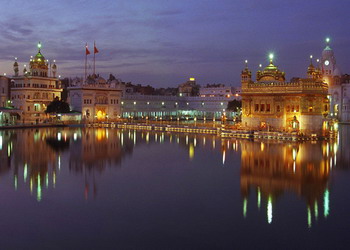Golden Temple

Amritsar is at the epicentre of the
Sikh faith, for it is home to the
Golden
Temple, the holiest of Sikh shrines. For
Sikhs it is both a place where Punjab's wealth is on
full display, as well as an important pilgrimage.
But it is not only Sikhs who come here. People from
all faiths come to the Golden Temple, a tribute to
the syncretist traditions of a faith whose holy book
is a compilation of the writings of men of different
faiths. Outside the sacred precincts of the Golden
Temple, you can enjoy this chaotic city while you
gorge on Punjabi specialities like makki ki roti,
sarson da saag and gur da halwa. It won't take you
long to discover that food is an obsession for the
locals, and it is rumoured that more desi ghee is
consumed here than anywhere else in the world.
History
When the Mughal emperor Akbar visited the third Sikh
Guru, Amar Das, he was deeply impressed with the
sage's wisdom and humility and insisted on gifting
some land as a wedding gift to the Guru's daughter.
The daughter, Bibi Bhani, was betrothed to a young
man called Jetha, destined to become the fourth
Guru, Ram Das (a responsibility he saw through from
1574-1581).
In 1574 AD, Guru Ram Das settled by a pool which
was said to have miraculous healing powers. He
further excavated it and named it Amrit-Sarovar
(Pool of Nectar). In 1577, he bought the pool and
another tract of land (to add to the gift of land)
and secured Sikh ownership from the local Jats. As
the land was strategically located on the silk route
many merchants flocked to this region. Guru Ram Das
encouraged them to settle and trade near and around
the shrine. Many more followers soon settled near
the temple and the village of Guru-ka-Chak grew.
This soon developed into a small town called
Ramdaspur. It was later renamed Amritsar after the
holy tank or the Pool of Nectar-Immortality where
the Golden Temple now stands.
Guru Ram Das' son-in-law and successor Guru Arjan
Dev then built the Hari Mandir in the middle of this
tank. He requested the great contemporary Muslim
mystic, Mir Mohammed Muayinul Islam, popularly known
as Hazrat Mian Mir of Lahore, to lay the foundation
stone. The Temple was completed in 1601 and the Adi
Granth was placed inside it. The pillage and plunder
of this city began in 1757. In 1762 Ahmed Shah
Abdali sacked the town and razed the temple to the
ground. The Temple was rebuilt in 1764 with its
domes plated in gold, which is when it was
officially named the Golden Temple.
Amritsar played an important role in India's
fight for independence against the British, with its
residents providing active support to the freedom
movement. Both the All India Congress Committee and
the Muslim league held their sessions in Amritsar in
1919, the year of the Jallianwala Bagh massacre.
Amritsar, the city of the Golden Temple, was an
important business centre. Its status was similar to
a wazir, in charge of managing the king's finances.
The city suffered terrible losses once again during
the Partition of India in 1947 - communal riots
broke out and refugees poured in from the other side
of the border, while the city wept.
In the early 1980s Amritsar became centre of a
violent political controversy when Sikh extremists
tried to rid the state of Punjab of non-Sikhs and
attempted to create an independent Sikh homeland
called Khalistan. They made the Golden Temple their
hideout and the centre for their activities. The
government retaliated with Operation Bluestar.
Amritsar has survived a calamitous past and is now a
thriving industrial city.
Places to visit
The
Golden Temple
The Golden Temple The best time to visit the Golden
Temple is the early morning when it gleams, pale and
ethereal, in the dawn. This is also the time when
its reflection in the Amrit Sarovar - the Pool of
Immortality - is untrammelled by the splash of
bathers' feet. The Golden Temple (Swarna Mandir) was
originally called Hari Mandir (Temple of God) and is
now also known as Darbar Sahib (Divine Court). It is
the epicentre of one of the great faiths of India.
All are welcome here for this is a truly syncretist
faith whose holiest book is a collection of hymns by
enlightened men of different religions.
Jallianwala Bagh
Is a peaceful park with picnicking families and
college kids, but move to a section of the wall
which still has visible bullet marks, and you will
be reminded of one of the most horrific events in
colonial Indian history. When the Rowlatt Act
(1919), which gave the British the power to arrest
and imprison Indians without a trial if suspected of
sedition, was imposed on Indians it was severely
criticised and regular hartals (strikes) were
organised to protest the law. Then Lieutenant
Governor of Punjab, Sir Michael O' Dwyer, arrested
an Indian leader causing great unrest among the
people. On April 13,1919 (also the festival of
Baisakhi) around 10,000 people gathered at the
Jallianwala Bagh to peacefully protest the new law.
General Dyer had been called to Amritsar to return
the city to order. He arrived at the Bagh with
150-armed soldiers, ordered the crowd to disperse
and two minutes later inhumanly commanded his troops
to open fire. The square was surrounded by high
walls and the soldiers had blocked the only entrance
(and exit) to the compound. The firing (1650 rounds)
continued for about 15 minutes and people were shot
as they tried to jump the wall while others drowned
after they jumped into the well to escape the
relentless onslaught of bullets, most of which found
their mark. About 400 people (including children)
died while 1500 were left wounded. Though there was
an international outcry over this horrific
uncalled-for massacre neither Dyer nor O'Dwyer was
ever charged with any crime. In response to this
massacre, Nobel laureate Rabindranath Tagore
returned his knighthood and Gandhi began his program
of civil disobedience announcing that 'co-operation
in any shape or form with this satanic government is
sinful'.
In 1997 Queen Elizabeth II visited Jallianwala
Bagh and though she laid a wreath on the memorial to
the victims no official apology was made.
Jallianwala Bagh is a five-minute walk from the
Golden Temple. The stone well has been preserved as
a monument to the victims (120 bodies were recovered
from the well) and the "flame of liberty," a 45 foot
flame-shaped red sandstone pillar set in a pool, was
built in 1961 as a memorial. The park is open from 6
am to 7 pm in summer and 7 am to 6 pm in winter. The
Martyr's Gallery which features portraits of heroes
involved in the incident, is open from 9 am to 5 pm
in summer and 10 am to 4 pm in winter.
Durgiana Mandir
An impressive Hindu temple built in 1921 by two
Amritsari philanthropists is dedicated to Goddess
Durga. The complex also houses the Durga Mata Mandir,
Bhairon Mandir and the Hanuman Mandir. During the
Dussehra Navratras, parents follow a quaint custom
(unique to Amritsar) of dressing up their male
progeny as langoors (a species of monkeys), probably
to honour Hanuman, the monkey god. The dome of the
mandir is beautifully illuminated at night during
fairs and festivals.
Gole Bagh
Is a huge park spread across 18 acres of land from
the Chattiwind gate to the outskirts of Gilwali
Gate. It lies near the Gobindgarh fort, which is
being used by the defence forces right now and is
therefore not open to visitors.
Kuka Memorial
The Kuka movement founded by Guru Ram Das (a warfare
expert in Maharaja Ranjit Singh's army) played an
important role in the freedom struggle. On 14th June
1871, the Kukas entered the Amritsar slaughterhouse
and freed the cows after murdering the butchers. In
retaliation, the British government prosecuted and
awarded capital punishment to 12 innocent Hindus and
Sikhs. The Kukas, on the advice of their Guru, then
confessed their involvement and surrendered to the
authorities. A memorial was then built to those who
were executed or sent to Kaalapani Prison in the
Andamans.
Mata Temple
This Hindu temple (north-west of the station)
commemorates Lal Devi, a bespectacled 20th century
female saint and was developed along the lines of
the famous Vaishnodevi temple in Jammu. Women who
wish to have children come here to pray. The temple
has a series of vivid shrines and grottoes.
Jama Masjid Kherudin
The Jama Masjid Kheruddin, built in 1876, is located
at the Hall Bazaar. On 9th April 1919, the bodies of
20 freedom fighters (mainly Sikhs and Hindus) shot
by the British General, were brought to this Masjid
for their last rites.
Samadhi of Baba Rode Shah
This is a unique and popular tomb that lies on the
Amritsar-Majitha road. One of the few places in
India where offerings and prasad are given in the
form of IMFL (Indian-made foreign liquor) or country
liquor. Nothing is diluted in any way and must be
'slammed back' neat. It is said that the Baba used
to meditate at the place of the present samadhi
(tomb) and he once blessed a childless couple who
gave birth to a son soon after. The Baba refused to
accept the money the grateful couple offered him,
but asked the couple to bring a bottle of liquor and
distribute it among his devotees instead. Though he
passed away in 1924, the tradition is still going
strong. Among the more famous devotees of Baba Rode
Shah was the singer Mohammed Rafi.
Ram Bagh
Maharaja Ranjit Singh built this small palace and
park in 1819. It lies in the newer, northern part of
Amritsar. It used to serve as a summer residence for
the philanthropic, one-eyed Maharaja (who rebuilt
the Golden Temple) between 1818 and 1837 and now
houses the Ranjit Singh museum, which has paintings
and weapons dating back to the Mughal period.
You can tell from Darshani Deorhi (gate) on the
south edge of the park that strong defences and a
moat originally surrounded it. Ram Bagh also houses
the Lumsden, Service and Amritsar Clubs, a
children's park and zoo and is a very pleasant place
to take a walk.
The museum is open - Tuesday-Sunday, 10 am to
4:45 pm, Rs 5 entrance.
Location :
Amritsar is the largest (and holiest) city in the
State of Punjab. An important centre for border
security in north-west India, it is located close to
the Indo-Pak Wagah border (29 km west).
